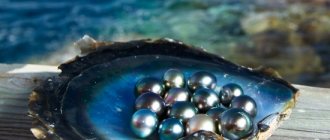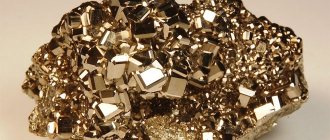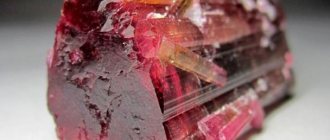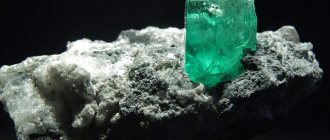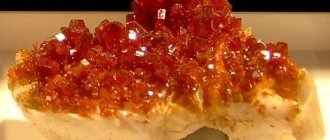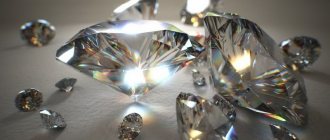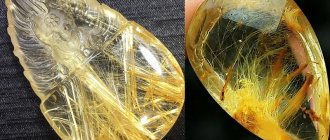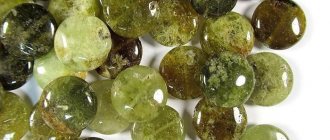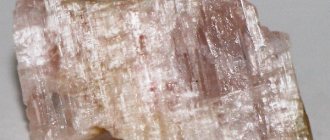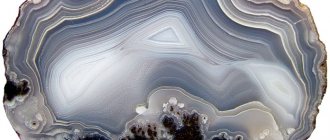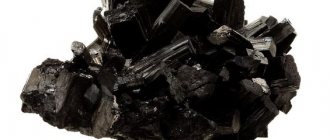Ruby is the most expensive mineral. In ancient times, it was valued even higher than diamond. It occupies a very high position among other precious gems. This mineral is a variety of red corundum.
The history of ruby goes back thousands of years. It was known to many nationalities, who considered it a worthy decoration and a symbol of prosperity. People called this stone their talisman and amulet. Ruby is used to create jewelry and products. It was identified with material well-being and became an elegant addition to the crowns of rulers. Simple objects acquired special value and showiness when they were decorated with this mineral.
The red ruby is called “fire” due to its resemblance to flame when it reflects light. In Rus' it was called “yakhont”.
Rubies are mined all over the world, except Antarctica. The most valuable specimens are those from Asia. They are brought from deposits located in Sri Lanka, Thailand, Tajikistan and East Africa (Kenya and Tanzania).
There are no stones of the same color. They play and shimmer in any shade of red. There are corundums of various shades: light pink, crimson, bright red, brown and red with a tint of purple.
The highest value are minerals, inside of which you can see a six-pointed star. They were called “star rubies”. Stars are found in stones of any color. This is quite a rare occurrence. For this reason, such specimens have a fairly high cost.
There are also more affordable rubies. They are opaque. To make them crystal clear, heat treatment is necessary. Such stones are called refined.
Synthetic versions are also currently being produced. Initially they were created in France. They are very similar to the original. It is not easy to distinguish them from natural rubies.
Many people know the healing and magical qualities of ruby, and therefore people strive to purchase it. However, they do not always think about the authenticity of the stone. But it should be borne in mind that only natural minerals can have a beneficial effect on the life, health and internal state of their owner. Copies and fakes do not have such properties.
Ruby in human history
There are several versions about the appearance of rubies in Europe:
- The ruby stone was brought by soldiers of Alexander the Great from India.
- Under the name “carbuncles” the stones were brought from Africa.
- The most commonplace and most likely way is with trade caravans.
In one of the ancient Greek cities in the temple there was a statue of Hera (the wife of the main god).
Gilded, studded with gems, the goddess on her head carried a gem, which was called the “Landlight”. And this is a quote from Lucian:
“It’s worth dwelling in a little more detail on the stone that is located on Hera’s head. His name is “Lightlight”, and this name fully corresponds to the action he performs: at night he shines so brightly that he illuminates the entire temple as if with many lamps. During the day, when this light weakens, the stone in appearance becomes like fire.” By the way, if you haven’t read Lucian, read it. His gossip about the gods and the details of their lives is no less fascinating than Brazilian TV series. And much more frank...
Since ancient times, a special property of the ruby stone was considered to change color if you bring (or dip) the gem into food or drink. This property was of great value to the powers that be. Many of them were afraid of being poisoned - what if the heirs got tired of waiting for the throne to become vacant.
History and origin
The exact conditions for the formation of ruby have not yet been established. However, scientists believe that this mineral originates in a thin layer between magma and the solid crust of the earth. The formation of crystals occurs in geothermal conditions, when 3 elements are combined at high temperature and under high pressure - an oxygen bubble, chromium and aluminum.
This combination is rare to form large crystals. Most often, natural rubies are small in size. And only in the presence of chromium a red mineral is obtained. If this element is not present in the reaction, sapphires of blue, cyan and green colors are formed.
Crystals reach the surface during super-strong volcanic eruptions. The largest deposits of the mineral are found in areas where the greatest activity of the earth's crust was observed and large faults were formed. Large amounts of magma were ejected through them under high pressure.
Since ancient times, the ruby has been considered a symbol of power and has not lost this meaning.
What family is ruby from?
The family is called Corundi and contains several eminent "relatives".
Types of mineral:
- corundum is an opaque, granular, grayish stone;
- sapphires, crystals from blue to deep blue:
- ruby, pink to dark red in color;
- leucosapphire - transparent colorless crystals are found;
- green corundum, “oriental emerald”;
- violet corundum, “oriental amethyst”;
- Padparadschi, a stone of orange-yellow, greenish-yellow color.
Corundum crystals - sapphire and ruby - are twins in composition. The whole difference is a few percent of chromium oxide (in ruby) and iron, titanium - in sapphire. But what a difference in color! Fire and water, the heat of the flame and the coolness of the sea.
Ruby is a stone of the material world, sapphire is a stone of the spiritual world. But this is already from the realm of esotericism.
Compatibility with other stones
High-quality red rubies are diamond-cut and set in white or red gold. The most brilliant and elegant is the combination of diamond and ruby.
Note! The ruby stone is a symbol of strength, passion and power.
Ruby goes well with gems:
- beryl;
- amethyst;
- turquoise;
- emerald;
- coral;
- sapphire;
- agate;
- White pearls;
- lapis lazuli;
- cornelian.
Corundum has inconsistent compatibility with minerals:
- pomegranate;
- topaz;
- aquamarine;
- rose quartz;
- Moonstone;
- heliotrope;
- opal;
- jasper.
The nugget is completely incompatible with stones:
- onyx;
- malachite.
- sardonyx;
- obsidian;
Physics and chemistry of crystal
Characteristics of rubies:
- hardness 9 on the Mohs scale (only diamond is harder);
- dash color is white;
- the color of the stone is from pink-red to red-purple, with violet tones;
- glass shine;
- chemical formula Al2O3 (class of oxides) with an admixture of chromium.
Ruby is a stone of the first (highest) group of the first order according to the Russian classification.
The colors of rubies range from pink to red-black. The most “correct” ruby is “the color of pigeon blood.” This is a bright red color with a purple tint. Such crystals are extremely rare.
A gem with an asterism effect is considered very valuable. They contain rutile inclusions, which cause a “star in the stone” effect.
Physicochemical characteristics
The characteristics of ruby are almost the same as those of sapphire. Its formula is Ai203. The general name for all minerals with this chemical composition is corundum. The color is due to the inclusion of iron and chromium in its composition. The saturation of the tone depends on the content of these substances. Rare gems contain rutile impurities, which provide a star-shaped effect, clearly visible in processed stones.
The hardness of the mineral is 9 points. Its density reaches 3.99-4.10 g/cm². Refractive index - 1.763-1.772. The gem has a conchoidal fracture. Its syngony is trigonal. The stones are characterized by imperfect cleavage. Natural jewelry minerals have a high degree of transparency and glass luster.
The physical properties of ruby make this mineral an excellent jewelry material.
How a ruby is cut
There are technical conditions for processing rubies. The shape of the cut is determined by the shape of the girdle.
We recommend: BENITOITE - heavenly stone from Devil's Canyon
Traditional cut shapes:
- round;
- oval;
- rectangular;
- square;
- antique;
- emerald;
- marquis;
- pear;
- heart;
- fantasy.
Cabochons are cut with a flat or convex pavilion.
Ruby deposits
Every year they are mined less and less. And most of the crystals found contain defects.
The highest quality gems are mined in Myanmar. It was from there, from Burma (the former name of the state), according to mineralogists, that the first rubies spread.
Countries where gem deposits are located:
- Madagascar;
- Sri Lanka;
- Tanzania;
- Kenya;
- Tajikistan.
Russia does not have ruby deposits, but gems are occasionally found where corundum is mined. These are Karelia, the Polar and Southern Urals, the Kola Peninsula.
Where are red corundums mined?
In fact, rubies are quite common. They are mined on almost all continents, but only a small percentage of the stones found are of jewelry quality. Often the crystals are opaque or have an insufficiently saturated color. Such stones are not used for making jewelry.
The best gems were found in Burma. Up to 60% of high quality rubies are mined here. At the same time, the Burmese field has already been greatly depleted, so production is gradually declining. In the 20th century The largest rubies were found in this area, weighing up to 30-40 carats. In addition, gem-quality stones are mined in the following areas:
- Tanzania.
- Tajikistan.
- Afghanistan.
- Madagascar.
- Vietnam.
- Kenya.
The largest deposit of rubies is located in Burma.
Red and pink rubies are obtained in Sri Lanka and India. This gem is also mined in Russia. The highest quality specimens are found in the northern regions of the Ural Mountains.
Refined is also natural
Fewer and fewer rubies are being found. And the quality of most leaves much to be desired.
To improve the appearance of the stone, refining is used. It improves the shine, transparency and color, purity of the stone.
Refinement is not falsification, it is natural stone, slightly improved and corrected.
The International Jewelry Confederation (CIBJO) regulates when to inform the buyer about interference in the appearance of a stone, and when this is not necessary.
If the stone is subjected to:
- Filling cracks with unpainted resins, oils (excluding glass and synthetic resins).
- Heat treatment.
- Lightening.
In these cases, the buyer will not know that the stone has been refined.
If and when the stone was applied:
- HPHT processing.
- Irradiation.
- Cementation with glass, synthetic resins and other suitable chemicals.
- Laser processing.
- Coloring - here the seller is obliged to write in the certificate for the stone that the gem has been refined (and in what way).
Rubies can be subjected to heat and diffusion treatment, healing of surfaces, filling cracks with glass, and painting.
Primary colors
The base color is blood red. But the gem can also be fiery crimson in color, etc. The most valuable are stones that have a purple or bluish tint. This color is called pigeon blood.
The composition of the gem is close to sapphire, the latter also belongs to corundum. But it doesn't have such a wide range of colors. If someone talks about a green ruby, then most likely they are talking about a sapphire.
Meanwhile, a pink gem exists. This is a young gem with a light pink tint.
Growing crystals
Growing ruby crystals at home is no joke. Such an activity can become a hobby or turn into a means of earning money.
For those interested, details:
- We buy a Verneuil apparatus. It won't work without him, unfortunately. Although on the Internet craftsmen share the technology of “kitchen” manufacturing of the device.
- Pour the mixture into the funnel (salt of aluminum dioxide with chromium oxide).
- Turn on the burner.
- We wait.
The flame of the burner turns the powder into a melt, and a synthetic crystal grows on the stand.
Chemistry enthusiasts select and change the composition of the charge, adjusting the color and shade of the future ruby.
The resulting artificial crystals are red and transparent. Once you get the hang of it, the crystals will look no worse than a natural gemstone.
The crystal is prepared in 2-3 hours, the cost of electricity and chemical powders is literally peanuts. And the crystal will weigh 20-30 carats.
Unprocessed homemade crystals are readily purchased by craftsmen and jewelers for inexpensive jewelry.
Of course, any jeweler will understand that the gem is not real. But we wear fakes without knowing it. And here you will receive the joy of the creator.
Varieties
Ruby wears bright red color and all its shades. The mineral is divided into 2 types. This:
- "Pigeon's Blood"
The name of this species goes back a long way in history. A geologist from Switzerland saw that the stone had a color similar to the blood of a killed bird. That is why the type of ruby received such a strange name. - Star stone.
The precious mineral is obtained after processing. Experienced craftsmen reveal all the beauty and attractiveness of ruby. It is believed that the brighter the star, the higher the value of the gemstone.
Ruby Magic
This red gem is a stone of power. It has always been worn by people who have reached a high position, on whom the position of other people depends.
Esotericists have long believed that the magic of a ruby does not change a person. It only strengthens his character traits - both good and bad. Here the meaning of the stone is to be a catalyst for human qualities.
Ring with ruby
Therefore, a person with evil thoughts should not wear items made of red ruby. In this regard, the stone is “unprincipled”; it always indulges the passions of its owner. Whether it’s passionate love or the same passionate desire to ruin a rival by any means, to harm a rival... It’s better not to wish harm on your neighbors (and those far away too).
- Ruby is a stone of brilliance and vanity, pride and creative success.
- But these magical properties of the stone can energetically devastate the owner.
- Active, energetic people will find a harmonious ally in the gem.
- Ruby, its fiery color carries the symbolism of love, passion and fidelity.
- The magical properties of ruby protect the owner of the stone from evil forces and from astral attacks.
- If the color or shine of a gem has changed, this means you should be wary. These are signs of possible danger.
- Dedicated magicians love ruby - the stone gives them strength and power over the lower astral plane.
- Fire is the element of ruby. And the flames of passions are subject to the flame-colored stone.
- It is important to know that ruby is a symbol of love, but carnal love.
We recommend: The color of innocence | WHITE SAPPHIRE
Interesting: some esotericists believe that the property of the ruby (lonely) is to attract loneliness. That is why it is recommended to wear rubies in pairs.
All properties apply only to real gems.
Where is the stone used?
Good quality natural crystals are used in jewelry. Artificial ones are used to create interior items, decorate clothes and shoes. The mineral is necessary for the manufacture of laser systems and a number of devices. It is often used in quantum electronics to create watch mechanisms.
Amulets and talismans with ruby
Charms with crystals have magical properties. Such objects have powerful energy.
If the family has a talisman with such a stone, it will strengthen the relationship and help the couple overcome all problems without scandals. It is believed that this item will help maintain the fidelity of spouses and prevent love from extinguishing.
Talismans and amulets with rubies endow a person with certain qualities.
Amulets with gems will help you avoid the evil eye and damage. Such products protect their owner from malicious intent on the part of other people. In addition, they help determine the purity of the interlocutor’s thoughts. If he lies, the stone will darken.
We are treated with ruby
In the Middle Ages, healers tried to carry a ruby amulet with them - it was believed that it would protect against the plague.
Esotericists insist that ruby jewelry for healing should be worn so that the stone touches (or is as close as possible) to the sore spot.
Since ancient times, it has been believed that water infused with ruby for several days has healing properties on humans.
Esotericists claim that regular intake of such water will relieve insomnia.
When treating inflammation of the tonsils or middle ear, lithotherapists advise wearing a necklace or earrings with a ruby.
The healing properties of the mineral will help (according to lithotherapists):
- improve heart health (if you wear a crystal in a ring or pendant);
- helps recover from the consequences of a stroke;
- relieves symptoms of epilepsy;
- promotes healing of inflammation of bone tissue;
- useful to wear for chronic tonsillitis;
- for women, the stone helps to conceive and bear a child safely;
- relieves depression and nervous disorders;
- helps cure gastrointestinal diseases;
- For older men, a ruby bracelet will help cope with “male” problems.
Caution: One of the properties of ruby is to slightly increase blood pressure.
If you have blood diseases, you should not wear ruby jewelry.
If the owner is on the verge of a nervous breakdown, or under severe psychological stress, it is better to remove the ruby jewelry. Esotericists gloomily joke that a stone can “criminalize” the owner in an inadequate state.
Who is suitable according to the horoscope?
The meaning of red corundum in astrology is warmth, happiness and joy. But it is not suitable for all people. How actively the properties of ruby will manifest themselves depends on the zodiac sign under which the person was born. It will help some better than others, and some should not wear the gem at all.
For those who are not suitable for red corundums, we can recommend other red stones.
The mineral is good for Aries , Sagittarius and Leo . Thanks to it, they can become more attractive to the opposite sex, healthier and richer. For those of them who are endowed with power, the crystal will tell them how best to use it for the benefit of others. At the same time, the mineral will help the wearer become calmer and more tolerant of others.
For Capricorns, the mineral will become a strong amulet, help change life for the better, and reveal dormant talents.
Virgos and Taurus are better off choosing garnet or another red gemstone over ruby. Their aura may conflict with the energy of the stone and prevent it from revealing its full potential. There will be no serious problems, but no benefits either.
As for other zodiac signs, they can wear a ruby, but it will take a little time for the gem to get used to such a wearer. To make attuning to the stone faster, you can meditate by looking at the corundum for ten to fifteen minutes every day.
Astrological properties of rubies
The element of ruby is Fire. Now astrologers attribute the gem to the patrons of Leo and Aries. Their fiery, ardent nature will quickly find a “common language” with ruby. It is better to wear the stone in gold. Don’t rush to put on the purchased jewelry. Wait until the Sun moves into the constellation Aries or Leo. Then compatibility with the stone will be complete.
Jewelry with ruby
Ancient astrologers believed that the gem was suitable for Sagittarius according to their zodiac sign.
Signs not suitable for ruby according to the horoscope:
- Virgo;
- Calf;
- Cancer.
The patron planets of the stone are the Sun, Mars.
Interesting Facts
Large, high quality rubies are being discovered less and less often. Moreover, on May 13, 2015, a “blue blood” gem weighing 25.59 carats was sold at the Salisbury auction for a record $30 million.
The largest ruby that has been mined weighs more than 7 years. He was listed in the Guinness Book of Records. Ruby is the most frequently mentioned gem in the Bible.
In ancient times and the Middle Ages, many types of red stones were considered rubies. The large “Black Prince” crystal, which adorns the British crown and was considered a ruby, turned out to be a spinel.
Crystal Care
For all its hardness, ruby is a fragile stone. It is necessary to protect ruby products from falling or hitting hard surfaces.
But ruby is able to scratch other gems - its hardness is second only to that of diamond. Therefore, a separate house - a case or bag made of dense soft fabric - is suitable for decoration. Rubies do not like to be exposed to the hot sun for long periods of time, so store them in the dark and avoid wearing jewelry with these stones in hot countries.
Cleaning at home is simple:
- If your jewelry is dirty, dilute baby soap in warm water and carefully rinse the stone in this solution. Use a used (not hard) toothbrush or just a napkin. Rinse the jewelry and wipe gently with a dry cloth.
- If you are going to work with your hands, remove the ruby ring. Household chemicals are not at all beneficial for gems.
- It is better to take heavily soiled jewelry to a jeweler, he will clean it using special methods and means.
We recommend: APATITE - the many-sided deceiving mineral
Interesting: choose a place to store ruby jewelry in the southern part of the house. According to Feng Shui, this will increase the social status of the family in general and the owner in particular.
How to wear and care
Ruby jewelry is prized for its aesthetic quality and rarity. To maintain their shine, we recommend that you take extra care and handle them with care. These precautions for use and care will keep your jewelry in perfect condition for a long time.
It is advisable to avoid wearing jewelry in the following situations:
- When washing your hands, so that soap deposits do not get into the cavities and become dull;
- When you are engaged in activities that require sudden movements (gardening, cleaning, washing dishes). Remove ruby jewelry to avoid damaging it;
- When playing sports, avoid impacts and scratches.
Caring for the mineral is simple. But it needs to be done in a timely manner. Clean the ruby with warm water, rubbing gently with a soft brush, and dry with a soft cloth.
How to spot a fake
Even centuries-old jewelry can be set with an artificial ruby. Most Soviet jewelry sparkles with synthetic rubies.
It is not easy to distinguish a natural ruby from an artificial one. Without special equipment and analysis, the stone can easily be confused with spinel.
The best advice for anyone who wants to determine the authenticity of a stone in jewelry is to seek the help of a gemologist or jeweler.
You should buy expensive jewelry with rubies in salons where you will be provided with a certificate. It verifies that the stone is natural and provides the size, cut and data of the gem.
It is difficult to determine the authenticity of a stone without specialists. Try:
- Dab your fingernail or coin firmly across the surface. A cheap fake will have a scratch. A natural ruby can only be scratched with a diamond.
- Scratch the ruby onto glass or ceramic. A red scratch remained - in the hands of a mineral softer than ruby. Or refined stone.
- Under ultraviolet light, a natural gem will glow like a coal. Synthetic will give an orange-crimson glow.
- In daylight, sunlight, natural stone will look deep pink. Indoors, under artificial lighting, the color will change to darker.
- Natural ruby is reluctant to “share its warmth.” Hold your finger (or apply it to your eyelid, to the tip of your nose) the stone. If it heats up quickly, it's a cheap fake. Remains cold for a long time - there is a high probability that the stone is natural.
But only a real gemologist can distinguish a fake and give a guarantee (with a piece of paper and a seal). He will check (instrumentally) the authenticity of the ruby.
About the significance of the precious rock
According to ancient legend, ruby means the eyes of a dragon, which is associated with the property of shining in the dark. This noble mineral is intended for royalty. It symbolizes love, greatness, power, dignity, health, beauty, strength.
Healers believe that rich red yakhont relieves the blues, restores mental balance, and strengthens vital energy.
The jewelry used to be worn as an amulet of good luck. The warriors with him were convinced of victory over the enemy. The priests sewed yakhont into the skin in order to adopt the magic of the natural breed and become invulnerable. The Romans, Greeks, Burmese, Slavs and other peoples attached great importance to this solar mysterious stone.
Nowadays, corundum is especially revered by jewelers, who offer a huge assortment for women and men. Wearing jewelry with a dark red tint for a long time gives confidence in one’s own abilities, directs the owner decisively towards the goal, and stimulates a person to receive joy from earthly pleasures.
This mineral is especially recommended to abandoned lovers, whose energy helps to overcome pain, resentment, disappointment and accumulate reserves of love for a new relationship.
Rubies in Russia and the rest of the world
In describing the characteristics of ruby, Russia has “its own, special path of development.” Jewelers around the world use the GIA system.
Ruby Jewelry
According to Russian technical specifications, the main characteristics of the gem:
- color;
- purity.
The definition of color is divided into hue, lightness, saturation.
The GIA tables and methodology apply to more than just rubies. It can be used to determine the quality of any gemstone.
Favorable time to purchase
The optimal day to buy jewelry with dragon blood is the 17th of the lunar month.
The first use should occur on the 3rd day of the next lunar month.
The gem has its maximum power on the 3rd day of each lunar cycle.
Scarlet yacht is bought on the 17th day of the lunar month
